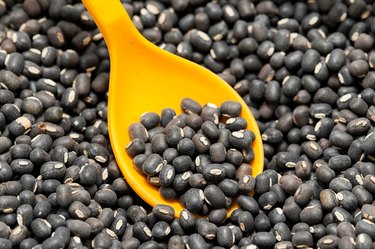
Legumes are often listed as healthy foods to incorporate into a well-rounded or vegetarian diet, but many people don't know how to cook them. Urad dal, a popular Indian pulse with a distinctive speck on the side, often gets overlooked for this reason — but it shouldn't. Urad dal is easy to cook!
Tip
Cooking urad dal is simple. Rinse it under cold water and then place it in a pot, covering it with 1 inch of water. Bring the water to a boil on the stove and then reduce it to a simmer. Cover and let cook for an additional 30 to 45 minutes before draining and adding seasonings of your choice.
Video of the Day
Video of the Day
What Is Urad Dal?
Urad dal is part of the legume family and while it highly resembles the black beluga lentil, it's technically not a lentil. Rather, it's a "pulse," which is the edible seed of a legume — and urad dal is more closely related to the cowpea and mung bean than anything else.
Black and oval-shaped with a noticeable white speck on the side, it can be found at most grocery stores and is an important culinary ingredient in many popular Indian dishes, such as dal makhani, dosa and papadum.
Read more: A Balanced Indian Diet
When searching the aisles or your online shopping cart for urad dal, take note. Urad dal is sometimes labeled as "black gram dal or "split black gram" at the grocery store and is often sold in bulk. Don't be afraid to stock up, though — like other pulses, urad dal is relatively inexpensive, lightweight and has a fantastic shelf life. It can be easily stored dry in your pantry for months without going bad.
Cooking Urad Dal
Cooking urad dal is simple and low-maintenance:
- Pick out any small debris; then rinse the urad dal well. Let dry.
- Place dry urad dal in a large container; add 10 cups of cold water for every 2 cups of urad dal. Cover and refrigerate eight hours or overnight.
- Pour the urad dal into a pot, covering fully with water.
- Place the pot on the stove and turn the burner on high.
- Bring the water to a boil and then lower the heat to a simmer.
- Cover and cook on simmer for approximately 45 minutes to two hours or until the urad dal is tender.
- Stir occasionally and add more water, as needed.
- Once done, drain any remaining water and mix in spices of your choice, adding a little bit at a time until agreeable with your flavor palate. Try seasonings like salt, pepper, curry powder and garlic.
- Serve alone, over a bed of rice or alongside our Buddha Veggie Rice Bowl or Colorful Rice-Pilaf. Enjoy!
Tip
For added deliciousness, add sautéed onions and diced tomatoes to your urad dal.
Based on the USDA's nutrition facts for lentils, a 1-cup serving of cooked urad dal contains approximately 230 calories.
Legume and Pulse Nutrition
Legumes have earned quite a bit of praise in the health and wellness community because they contain some of the nutrients found in both the protein and vegetable food groups.
They are packed with protein, iron and zinc — just as you would expect from red meat — but they don't come with the same negative health risks commonly associated with high cholesterol and increased saturated fat intake. Legumes are also loaded with fiber, folate and potassium, healthy nutrients commonly found in the vegetable kingdom.
Pulses — which again, are the seed of a legume — are being specifically and increasingly recognized for their role in promoting good health too. North Dakota State University suggests that eating pulses regularly may reduce the risk of heart disease, diabetes and certain types of cancer. Plus, they are naturally gluten free and accommodate a vegetarian or diabetes diet: all the more reason to stock your pantry with urad dal today.
Read more: Health Consequences of Too Many Lentils
- NutritionFacts.org: “Legumes”
- USDA: “Nutrition Facts for Lentils (Cooked)”
- American Heart Association: “Eat More Chicken, Fish and Beans”
- North Dakota State University: ”Pulses: The Perfect Food, Healthy to Eat, Healthy to Grow; Peas-Lentils-Chickpeas”
- University of Nebraska-Lincoln's Institute of Agriculture and Natural Resources: "Cooking Dry Beans From Scratch Can Be Quick"